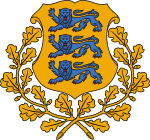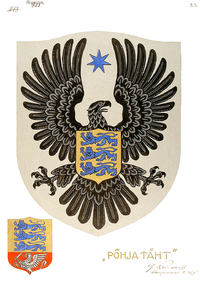- Coat of arms of Estonia
-
Coat of arms of the Republic of Estonia 
Versions 
The lesser coat of armsDetails Adopted June 19, 1925.
April 6, 1993Escutcheon Or, three lions passant guardant azure Other elements A garland of oak leaves surrounds the greater arms. The coat of arms of Estonia is a golden shield which includes three slim blue passant gardant lions in the middle, with oak branches along the side of the shield. The three lions derive from the arms of Danish king Valdemar II who had conquered northern Estonia in 1219. The lions became part of the greater coat of arms of Tallinn, the center of Danish government in Estonia, and the knightages (ger. ritterschaften) of Harria and Viru. In 1346, Denmark sold its Estonian dominion to the Teutonic Order after its power had been severely weakened during the St. George's Night Uprising of 1343-1346. The three lions, however, remained the central element of the greater coat of arms of Tallinn. In later centuries, the motif of the three lions transferred to the coat of arms of the Duchy of Estonia, the Ritterschaft of Estland, and to the coat of arms of the Governorate of Estonia.
The Riigikogu (the state assembly) of the independent Republic of Estonia officially adopted the coat of arms on June 19, 1925.
The coat of arms was officially banned following the occupation of Estonia by the Soviet Union in 1940, and replaced with the Soviet-inspired coat of arms of the Estonian SSR. Soviet officials persecuted and jailed anyone using the coat of arms or the national colors of Estonia. The readoption of the national symbols marked the completion of the struggle for independence which was finally achieved on August 7, 1990, and regulated by the Law on State Coat of Arms of April 6, 1993.
References
- Estonian Institute National symbols of Estonia. Retrieved October 30, 2005.
Coats of arms of Europe Sovereign
states- Albania
- Andorra
- Armenia
- Austria
- Azerbaijan
- Belarus
- Belgium
- Bosnia and Herzegovina
- Bulgaria
- Croatia
- Cyprus
- Czech Republic
- Denmark
- Estonia
- Finland
- France
- Georgia
- Germany
- Greece
- Hungary
- Iceland
- Ireland
- Italy
- Kazakhstan
- Latvia
- Liechtenstein
- Lithuania
- Luxembourg
- Macedonia
- Malta
- Moldova
- Monaco
- Montenegro
- Netherlands
- Norway
- Poland
- Portugal
- Romania
- Russia
- San Marino
- Serbia
- Slovakia
- Slovenia
- Spain
- Sweden
- Switzerland
- Turkey
- Ukraine
- United Kingdom
- (England
- Northern Ireland
- Scotland
- Wales)
- Vatican City
States with limited
recognition- Abkhazia
- Kosovo
- Nagorno-Karabakh
- Northern Cyprus
- South Ossetia
- Transnistria
Dependencies
and other territories- Åland
- Faroe Islands
- Gibraltar
- Guernsey
- Jan Mayen
- Jersey
- Isle of Man
- Svalbard
Other entities Categories:- National symbols of Estonia
- National coats of arms
- Estonian coats of arms
Wikimedia Foundation. 2010.




